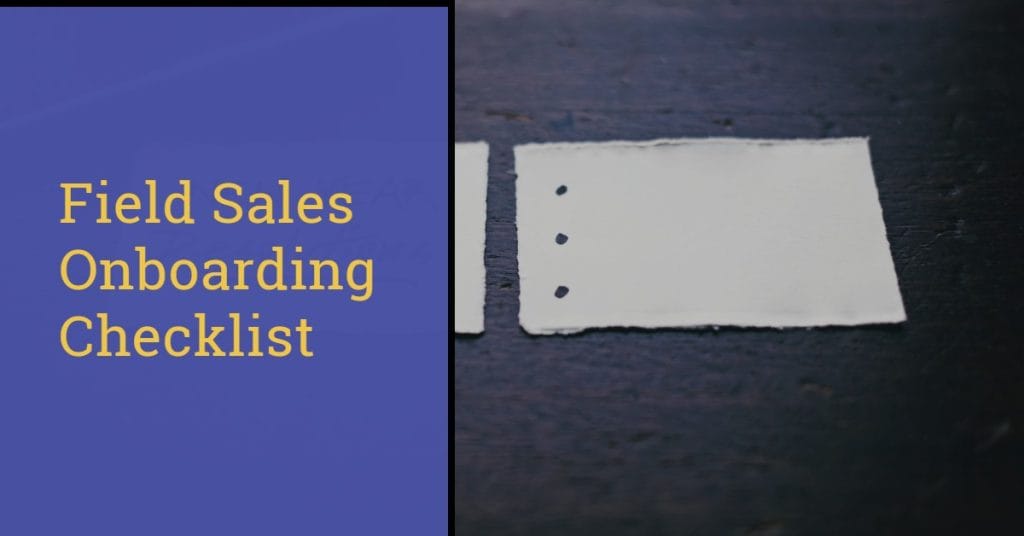You want your sales reps to be as successful as possible, right? Then you need to invest in sales onboarding. Doing so will help your team reach peak productivity and boost retention.
According to research, these are two areas where modern sales teams struggle.
A recent Forbes study found that average reps spend just 35.2% of their time selling; while a Bridge Group report says the average tenure for professional sellers is only 1.4 years. Yikes!
Sales onboarding isn’t a silver bullet to these problems—but it’s as close to one as you’re likely to find. That’s why we put together the comprehensive sales onboarding checklist below. Keep reading to learn how you can reliably onboard new reps in as little as 90 days. Let’s go!
The Comprehensive Sales Onboarding Checklist
As mentioned above, a solid sales onboarding program can be completed in about three months. During that time, new hires will meet their colleagues, learn about their individual duties, master their roles, and gradually transition into full-fledged, independent team members.
In this section, we break down these tasks into 30 day, 60 day, and 90 day goals. That way you know exactly which ones to tackle and when.
30-Day Checklist: The First Month of Sales Onboarding
The first 30 days of the sales onboarding process is about integrating your new hire into your company. You want to introduce them to their teammates, get them familiar with your tech stack, and begin training them to make sales for your organization. Here’s the checklist:
- Introduce the Team: Who will your new hires work with? Introduce them to their colleagues, both on your sales team and in other departments they may need to interact with. This will help get them acclimated to your company’s culture.
- Introduce the Tech Stack: Next, show new hires the tools they’ll use on a regular basis. For field sales teams, your tech stack might include apps like SPOTIO, Salesforce, and Zoom. Whatever the case may be, allow your reps to get familiar with their new tools.
- Provide Initial Training Sessions: Now it’s time to teach your reps how to sell your company’s products. Your training at this stage of the sales onboarding checklist should be broad, helping reps gain product knowledge and learn basic sales techniques.
Set Rep Expectations: Finally, tell new hires what you expect them to achieve—both in the short and long-term. This will keep them striving towards the right goals.
60-Day Checklist: The Next 30 Days of Onboarding Sales
The next 30 days of the sales onboarding process are about growth. You’ve built a strong foundation for your new hires. They know who their colleagues are, have become familiar with the tools your team uses, and have started to grasp your department’s sales strategy.
Now it’s time for them to sharpen their skill sets and become more autonomous. The checklist items below will help ensure that happens:
- Offer More In-Depth Training: Your new reps have a surface-level understanding of your company’s sales strategy. Now it’s time to dig deeper. Teach them the nitty gritty details they need to close deals. Even better pair them with an experienced rep, who they can shadow and learn the ropes from. This will expedite their training.
- Push for More Rep Independence: Most reps don’t make sales in their first 30 days. There are too many other tasks to handle, information to digest, etc. But they should be given a chance to sell something between day 30 and 60. We suggest starting them out on smaller accounts. Just make sure they’re supervised by an experienced seller.
- Provide Feedback on a Regular Basis: Next, schedule one-on-one meetings with new reps. This will give you a chance to assess their progress, identify areas of improvement, and deliver feedback in a constructive way. While these sessions will take time, they’re essential. After all, reps can’t improve if they don’t know what their weaknesses are.
- Introduce Reps to More Advanced Techniques: By the end of a rep’s first 60 days on the job, they should have consumed some advanced training and handled a few accounts on their own. This is great news, but don’t let them rest on their laurels. This is the perfect time to introduce them to advanced techniques they can use to boost sales.
90-Day Checklist: The Final Month of Sales Onboarding
The final stage of the sales onboarding checklist is about independence. New reps should be able to take what they’ve learned, implement it into their daily workflows, and make sales.
Here are four checklist items to make sure your reps are ready for prime time:
- Skills Assessments: Pay special attention to the processes, workflows, and outcomes your new reps achieve. You want to make sure they’re able to sell independently before you stop onboarding. A skills assessment can make this easy to determine. First, decide what reps need to prove. Then analyze their work to see if they meet your requirements.
- Independent Selling: The entire goal of sales onboarding is to produce competent and confident sellers in as little time as possible. So, new reps need to be able to make sales on their own before you can conclude their onboarding process. Start reps on small accounts. Then give them larger, more important accounts as their skills develop.
- Final Evaluations: Are your reps ready to contribute to your sales team in a meaningful way? Give final evaluations to each rep to make sure the answer is a resounding “YES!” Also, give reps long-term goals to strive for, as this will keep them hungry and motivated.
- Full Integration: Finally, ensure new reps are fully integrated into your sales teams’ culture and dynamics. They need to be able to close deals. But if they don’t “fit” with the rest of your employees, they’ll drag your entire department down. Avoid this if possible.
Master Your Sales Onboarding Process With SPOTIO
Every company needs to implement an effective sales onboarding process. Without one, new reps will struggle to contribute, grow frustrated, and seek alternative employment.
You know what else your company needs? Reliable software solutions that have been proven to help sellers close deals. For field sales teams, SPOTIO is the ultimate platform.
Once you get your hands in SPOTIO, your reps will be able to cut territories, generate leads, set appointments, plan efficient travel routes, communicate with prospects via multiple channels, automate an assortment of tasks, create customized reports, and more.
Sign up for a free demo of SPOTIO right now to see if it’s the right tool for your field sales team!
Sales Onboarding FAQ
The sales onboarding checklist above will help you onboard new sales reps effectively. But you probably have a few more questions about the process. We’re here to answer them for you:
What Is Sales Onboarding?
Sales onboarding is a structured method that companies use to bring new sales reps up to speed. The process usually involves introductions, in-depth training, and regular evaluations. When onboarding has been completed, new reps should have all of the information, skills, and confidence they need to be successful in their jobs.
What Are The Benefits of Sales Onboarding?
It will take you time and resources to build an effective sales onboarding program. But the effort you expend will be more than worth it because sales onboarding is extremely beneficial:
What Are The Benefits of Sales Onboarding?
It will take you time and resources to build an effective sales onboarding program. But the effort you expend will be more than worth it because sales onboarding is extremely beneficial:
- Better Engagement: Well-trained sales reps have the skills they need to close deals at a consistent clip. This will lead to better results and greater confidence—two things that will help your reps enjoy their work and fully engage with their employer.
- Improved Productivity: New reps often struggle to reach peak productivity levels. There are so many things to learn: people’s names, product benefits, sales strategies, software apps. Sales onboarding teaches them these things in a structured way. The result? Reps learn what to do and when to do it quicker than they otherwise would.
- Increased Retention: When your reps are engaged and productive in their work, they’ll enjoy more success. And successful sales reps rarely seek alternative employment. This is important because it costs an average of $97,690 to replace a single salesperson.
How Is Sales Onboarding Different From Sales Enablement?
Sales onboarding and sales enablement are two different processes—though both are important in their own right. Understanding these differences is essential:
- Sales onboarding is the process you’ll use to integrate new sales reps into your sales team. It will include introductions, sales training, evaluations, and more.
- Sales enablement is the process of equipping your sales team with the training materials, software programs, content pieces, and other resources they need to thrive.
Put simply, sales onboarding is what happens at the beginning of your new reps’ tenure with your company, preparing them to close deals. Sales enablement is an ongoing process that ensures your reps always have what they need to close deals consistently.
What Are Sales Onboarding Best Practices?
Like anything, there is a right way and a wrong way to onboard new sales reps. Keep these sales onboarding best practices in mind to make sure you do more of the former:
- Standardize the Process: Every new rep should go through the same onboarding procedures. This will ensure reps are trained in a similar way. (Note: don’t standardize your process until you find a winning approach. This will only guarantee subpar results.)
- Invest in Quality Sales Training: It may take more time and money than you’d like. But effective sales training will pay dividends down the road. Don’t cut corners here! Train new reps to the best of your ability, then enjoy the top-level metrics they produce.
- Shadow Veteran Reps: Speaking of training, one of the best ways to train new reps is to have them shadow a more experienced colleague. This will help them see your sales strategies in action, and pick up small tricks of the trade that often go unnoticed.
- Encourage Ongoing Dialogue: Your reps should feel free to speak to you about sales onboarding. What do they like about your program? What should you change to produce better sellers? When appropriate, add these suggestions to your process.
- Give Reps Access to Quality Tools: Every sales team needs to optimize their tech stacks. When sellers have access to top-rated tools, they’ll be more effective in their roles. Introduce new reps to the tools they’ll use early in the sales onboarding process. That way they can become familiar with them quickly, and use them to achieve success.
How Long Is Onboarding for a Sales Rep?
The short answer is: however long it takes to ensure your reps do their jobs effectively.
Most sales onboarding processes last for three months, hence the 90-day sales onboarding checklist above. But we won’t blame you if you decide to extend your program.
Research shows that it takes the average rep three months to interact with buyers, nine months to become competent in their roles, and 15 months to become a top performer. Fortunately, proper sales onboarding and sales enablement programs can cut these times in half!




